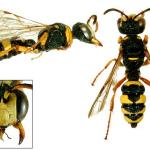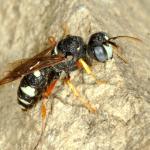The inclusion of this species on the British list is based on a probable vagrant from the Continent —a female collected by F Smith at Kingsdown, near Deal, East Kent, in August 1860 (not 1861 as quoted by Saunders (1896) and Richards (1980)). The specimen survives in the Smith Collection at Oxford under the species synonym, C. emarginata (Panzer, 1799).
As no records of this insect have been made since 1860, it is listed in the Appendix category (No records in the 20th century) of the Red Data Book (Shirt, 1987) and Falk (1991).
C. sabulosa is one of a large group of Cerceris species that preys on adult bees, particularly halictines but also Andrena, Panurgus, Hylaeus and Epeolus.
Its biology has been studied in Italy by Grandi (in Hamm & Richards, 1930), who found it nesting in hard soil. There were up to 24 cells per nest at depths of 7-12 cm, with 4-12 prey per cell. As in other Cerceris species, the prey often appeared to be only lightly paralysed. Authors of profile G R Else and J P Field.
1997



